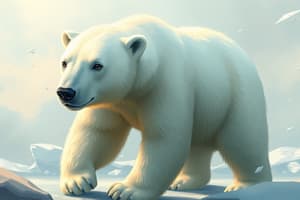Podcast
Questions and Answers
What happens to the Arctic air flow when the tropospheric vortex weakens significantly?
What happens to the Arctic air flow when the tropospheric vortex weakens significantly?
- The temperature in the Arctic region rises dramatically.
- The Arctic air stays confined within a single vortex.
- Cold Arctic air masses can push equatorward. (correct)
- The vortex strengthens and magnifies the jet stream.
What was the impact of the polar vortex in late January 2019 in the United States?
What was the impact of the polar vortex in late January 2019 in the United States?
- It produced heavy rainfall throughout the Midwest.
- It resulted in mild temperatures and light precipitation.
- It caused severe frostbite and school closures. (correct)
- It led to a significant increase in wind speeds.
Which of the following best describes the effect of a strong polar vortex on the mid-latitude Westerlies?
Which of the following best describes the effect of a strong polar vortex on the mid-latitude Westerlies?
- They remain unchanged in intensity.
- They become weaker and less persistent.
- They increase in strength and persistence. (correct)
- They completely reverse direction.
Which phenomenon often occurs as a result of a weak polar vortex?
Which phenomenon often occurs as a result of a weak polar vortex?
What are the 2013–14 United Kingdom winter floods attributed to?
What are the 2013–14 United Kingdom winter floods attributed to?
What distinguishes the stratospheric polar vortex from the tropospheric polar vortex?
What distinguishes the stratospheric polar vortex from the tropospheric polar vortex?
During which season is the stratospheric polar vortex typically strongest?
During which season is the stratospheric polar vortex typically strongest?
What initiates the development of the stratospheric polar vortex during autumn?
What initiates the development of the stratospheric polar vortex during autumn?
Which of the following events occurs when the stratospheric vortex breaks down during winter?
Which of the following events occurs when the stratospheric vortex breaks down during winter?
How did public awareness of the tropospheric polar vortex increase in 2021?
How did public awareness of the tropospheric polar vortex increase in 2021?
Flashcards are hidden until you start studying
Study Notes
Polar Vortices
- Large areas of cold, rotating air that encircle Earth's poles
- Exist on other rotating, low-obliquity planetary bodies
- Two types: stratospheric and tropospheric
Stratospheric Polar Vortex
- High-speed, cyclonically rotating winds at altitudes of 15 km to 50 km
- Strongest in winter, forms during autumn as polar night begins
- Increased temperature difference between pole and tropics causes strong winds
- Coriolis effect causes vortex to spin up
- Breaks down during spring as polar night ends
- Sudden stratospheric warming (SSW) occurs when the vortex breaks down during winter, impacting surface weather
Tropospheric Polar Vortex
- Area poleward of the tropospheric jet stream
- Extends from the surface up to around 10 km to 15 km
- Exists all year, strongest in winter
- Was mentioned in the news during the cold North American winter of 2013–2014
- Linked to extreme frigid temperatures in the central United States in 2021
Ozone Depletion
- Occurs most heavily within polar vortices, particularly over the Southern Hemisphere
- Maximum depletion in spring
Tropospheric Vortex Strength and Effects
- Strong: Well-defined and nearly circular shape, single vortex with a jet stream near the polar front, Arctic air contained
- Weak: Breaks into two or more smaller vortices, Arctic air flow becomes more disorganized, cold Arctic air can push equatorward, causing a rapid temperature drop
- Weakening: Linked to outbreaks of cold Arctic air, causing extreme temperatures, frostbite, and school closures
Polar Vortex and Weather Events
- United States and Canada:
- 2019: Deep freeze caused by a weakened polar vortex
- Frostbite warnings issued, hundreds of schools closed, 21 deaths
- Wind chills dropped below -50 °F (-45 °C)
- United Kingdom:
- 2013–14: Cold air from the polar vortex linked to winter floods
- 2009–10 and 2010–11: Severe cold blamed on the polar vortex
Antarctic Vortex
- Single low-pressure zone near the edge of the Ross ice shelf
- Strong vortex: mid-latitude Westerlies increase in strength and are persistent
- Weak vortex: high-pressure zones may push poleward, moving the vortex, jet stream, and polar front equatorward
- Results in cold snaps, with rapid and dramatic weather changes
Polar Vortex in Australia
- Known as a "polar blast" or "polar plunge"
- Drags air from Antarctica, bringing rain showers, snow, and gusty icy winds
Studying That Suits You
Use AI to generate personalized quizzes and flashcards to suit your learning preferences.




